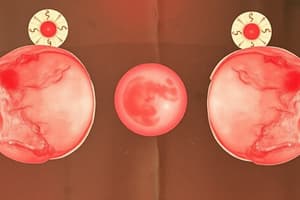Podcast
Questions and Answers
What is the most common type of teratoma that includes thyroid tissue?
What is the most common type of teratoma that includes thyroid tissue?
- Dysgerminoma
- Granulosa-theca cell tumor
- Immature teratoma
- Monodermal teratoma (correct)
Which statement regarding dysgerminoma is true?
Which statement regarding dysgerminoma is true?
- It primarily occurs in postmenopausal women.
- It consists of small cuboidal cells only.
- It is the ovarian counterpart of seminoma. (correct)
- It is commonly bilateral.
Which feature is characteristic of a granulosa-theca cell tumor?
Which feature is characteristic of a granulosa-theca cell tumor?
- It contains only theca cells without granulosa cells.
- It may potentially be malignant in 5%-25% of cases. (correct)
- Higher incidence is observed in adolescents.
- It predominantly arises from the stroma of the ovary.
Which type of tumor is associated with hydrothorax and ascites, referred to as Meigs syndrome?
Which type of tumor is associated with hydrothorax and ascites, referred to as Meigs syndrome?
What is the main origin of metastatic ovarian tumors noted in the text?
What is the main origin of metastatic ovarian tumors noted in the text?
What is the primary cause that can lead to oophoritis?
What is the primary cause that can lead to oophoritis?
Which type of cyst is categorized by having a lining that resembles normal follicular structure?
Which type of cyst is categorized by having a lining that resembles normal follicular structure?
What percentage of women with Polycystic Ovary Syndrome (PCOS) remains undiagnosed?
What percentage of women with Polycystic Ovary Syndrome (PCOS) remains undiagnosed?
Which ovarian tumor class is characterized by tumors like serous and mucinous tumors?
Which ovarian tumor class is characterized by tumors like serous and mucinous tumors?
Which clinical feature is NOT considered a criterion for diagnosing PCOS?
Which clinical feature is NOT considered a criterion for diagnosing PCOS?
In which type of cyst does progesterone secretion primarily occur?
In which type of cyst does progesterone secretion primarily occur?
Which type of ovarian tumor is noted for possibly being benign in approximately 60% of cases?
Which type of ovarian tumor is noted for possibly being benign in approximately 60% of cases?
What is a characteristic feature of serous cystadenomas?
What is a characteristic feature of serous cystadenomas?
Which feature differentiates papillary serous cystadenocarcinoma from serous cystadenoma?
Which feature differentiates papillary serous cystadenocarcinoma from serous cystadenoma?
Which statement is true regarding mucinous cystadenoma?
Which statement is true regarding mucinous cystadenoma?
What type of tumors resemble endometrial adenocarcinoma microscopically?
What type of tumors resemble endometrial adenocarcinoma microscopically?
Which of the following is considered a complication of benign serous and mucinous cystadenoma?
Which of the following is considered a complication of benign serous and mucinous cystadenoma?
What is a characteristic of Brenner tumors?
What is a characteristic of Brenner tumors?
Which type of ovarian tumor is associated with ovarian endometriosis?
Which type of ovarian tumor is associated with ovarian endometriosis?
What defines mature teratomas in ovarian tumors?
What defines mature teratomas in ovarian tumors?
What distinguishes borderline serous tumors from malignant forms?
What distinguishes borderline serous tumors from malignant forms?
Which type of cell structure is expected in mucinous cystadenocarcinoma?
Which type of cell structure is expected in mucinous cystadenocarcinoma?
Flashcards
Struma ovarii
Struma ovarii
A type of ovarian teratoma that primarily consists of thyroid tissue, usually benign but can transform into cancer.
Dysgerminoma
Dysgerminoma
A rare, malignant ovarian tumor that resembles seminoma in the testes.
Sex cord-stromal tumor
Sex cord-stromal tumor
A type of ovarian tumor arising from the sex cords or stroma, often producing hormones like estrogen or androgens.
Granulosa-theca cell tumor
Granulosa-theca cell tumor
Signup and view all the flashcards
Meigs syndrome
Meigs syndrome
Signup and view all the flashcards
Oophoritis
Oophoritis
Signup and view all the flashcards
Polycystic Ovary Syndrome (PCOS)
Polycystic Ovary Syndrome (PCOS)
Signup and view all the flashcards
Follicular Ovarian Cyst
Follicular Ovarian Cyst
Signup and view all the flashcards
Luteal Cyst
Luteal Cyst
Signup and view all the flashcards
Surface Epithelial Ovarian Tumor
Surface Epithelial Ovarian Tumor
Signup and view all the flashcards
Serous Cystadenoma
Serous Cystadenoma
Signup and view all the flashcards
Germ Cell Ovarian Tumor
Germ Cell Ovarian Tumor
Signup and view all the flashcards
Papillary Serous Cystadenocarcinoma
Papillary Serous Cystadenocarcinoma
Signup and view all the flashcards
Mucinous Cystadenocarcinoma
Mucinous Cystadenocarcinoma
Signup and view all the flashcards
Mucinous Cystadenoma
Mucinous Cystadenoma
Signup and view all the flashcards
Endometrioid Tumor
Endometrioid Tumor
Signup and view all the flashcards
Brenner Tumor
Brenner Tumor
Signup and view all the flashcards
Teratomas
Teratomas
Signup and view all the flashcards
Mature Teratoma (Dermoid Cyst)
Mature Teratoma (Dermoid Cyst)
Signup and view all the flashcards
Complications of Benign Serous and Mucinous Cystadenomas
Complications of Benign Serous and Mucinous Cystadenomas
Signup and view all the flashcards
Borderline Serous Tumors
Borderline Serous Tumors
Signup and view all the flashcards
Study Notes
Disorders of the Ovaries
- Inflammation of the ovary (oophoritis): Oophoritis is inflammation of one or both ovaries, often preceded by infection of the fallopian tubes or peritoneum. It's part of chronic pelvic inflammatory disease (PID), an inflammation and infection in the upper genital tract (uterus, fallopian tubes, and ovaries). Females under 35 are most at risk for PID and oophoritis. It's rare before menstruation, during pregnancy, or after menopause. Extensive inflammation with fibrosis can lead to infertility.
Non-neoplastic Cysts of the Ovary
-
Follicular ovarian cysts: A very common type of cyst arising from unruptured ovarian follicles. Often multiple, these cysts can grow large (over 10 cm), but are more typically small (around 1.5 cm). The lining resembles a normal follicle (granulosa and theca cell layer) and rarely secretes estrogen.
-
Luteal cysts: Cystically dilated corpus luteum, about 2 cm in diameter (can reach up to 3 cm) Often multiple, lined by luteal cells and usually secrete progesterone.
-
Chocolate cyst (endometriotic cyst):
-
Germinal inclusion cyst: Caused by germinal epithelium dipping into the ovarian stroma.
Polycystic Ovary Syndrome (PCOS)
- PCOS is a common condition affecting 12-21% of women of reproductive age. Up to 70% remain undiagnosed. Obesity is a risk factor. PCOS can cause infertility.
- Diagnosis requires two of three criteria:
- Oligomenorrhea/anovulation
- Hyperandrogenism (clinically reflected by hirsutism or biochemically by raised free androgen index (FAI) or free testosterone)
- Polycystic ovaries on ultrasound
Classification of Ovarian Tumors
-
Surface epithelial tumors:
- Serous tumors
- Mucinous tumors
- Brenner tumor
- Endometrioid
- Clear cell tumors
-
Germ cell tumors:
- Teratoma
- Dysgerminoma
- Choriocarcinoma
- Embryonal carcinoma
- Yolk sac tumor (endodermal sinus)
-
Sex-cord stromal tumors:
- Granulosa-theca cell tumor
- Sertoli-stromal cell tumor
- Gynandroblastoma
-
Soft tissue tumors:
- Fibroma
- Angioma
-
Metastatic secondary tumors:
Clinicopathological Features of Surface Epithelial Tumors
- Serous tumors:
- Benign (60%)
- Malignant (25%)
- Borderline (15%)
Serous Cystadenomas
- Grossly: Small or large (up to 40 cm in diameter), rounded, mostly unilateral, unilocular, filled with clear yellowish fluid, and can show papillary projections inside or outside the surface.
- Microscopically: The lining is a single layer of tall columnar ciliated cells and has small microscopic papillae.
Papillary Serous Cystadenocarcinoma
- Grossly: Papillary projections penetrate the cyst capsule (papillary processes on both sides of the cyst wall); solid loculi may be present.
- Microscopically: The lining epithelium is more than one layer, showing malignancy criteria, and psammoma bodies may be present.
Borderline Serous Tumors
- Grossly: Resemble benign serous tumors.
- Microscopically: Resemble malignant serous tumors but without stromal invasion.
Mucinous Tumors
- Benign (mucinous cystadenoma): 80%
- Malignant (mucinous cystadenocarcinoma): 5-10%
- Borderline (mucinous cystadenomas):
Mucinous Cystadenoma
- Grossly: Can be large, ovoid, or lobulated; usually unilateral; multilocular, filled with gelatinous material; thick and fibrous wall.
- Microscopically: Tumors are lined by tall columnar cells with apical mucinous vacuolation.
Mucinous Cystadenocarcinoma
- Grossly: Presence of atypia in the cells and invasion of the capsule.
- Microscopically: Solid masses of tumor.
Borderline Forms
- Same changes as malignant forms but without invasion of the capsule.
Complications of Benign Serous & Mucinous Cystadenomas
- Torsion of pedicle leading to hemorrhage
- Rupture leading to acute abdomen
- Pressure effects
- Malignant change in serous cystadenoma
Endometrioid Tumors
- 20% of all ovarian cancers
- 50% associated with ovarian endometriosis
- Grossly show solid & cystic areas; 40% are bilateral.
- Microscopically, the glandular structures resemble endometrial adenocarcinoma.
Brenner Tumors
- Mostly benign, unilateral, occasionally cystic.
- Vary from small lesions to large masses.
- Composed of dense fibrous stroma and nests of transitional cells.
Teratomas
-
Arise from totipotent cells, capable of differentiation into all layers of germ cells
-
Mature teratomas: Mostly cystic, small, "dermoid cysts"
- Lined by skin with adnexal structures; filled with hair and sebaceous secretion.
- Microscopically, composed of epidermis, hair follicles, sebaceous glands, teeth, cartilage, bone, thyroid tissue, and other organ tissues.
-
Malignant change (squamous cell carcinoma) in 1% of cases
-
Monodermal teratomas: struma ovarii (thyroid tissue) is most common, also may be carcinoid or combined.
-
Immature (malignant) teratoma:
- Most common in adolescents and young women (mean age is 18 years)
- Gross: bulky, solid with areas of necrosis and hemorrhage
- Microscopic: mixture of immature tissues, differentiating towards cartilage, glands, bone, muscle, or nerve
Dysgerminoma
- Ovarian counterpart of seminoma
- Age incidence: childhood, teens, to twenties.
- Gross: solid tumor; 90% unilateral; fleshy, yellowish-white to gray-pink
- Microscopic: sheets and cords of large cells with clear cytoplasm, separated by scant fibrous stroma containing lymphocytes.
Gross and microscopic appearances of dysgerminoma: (Image provided)
Clinicopathological features of Sex cord stromal tumors
- Arise from sex cords of the embryonic gonads or ovary stroma.
- Frequently functioning(secreting estrogen (granulosa and theca tumors) or androgen (Sertoli-Leydig cell tumor).
Granulosa-theca cell tumor
- Common in postmenopausal women
- Gross: unilateral, solid and cystic areas, varies in size, encapsulated.
- Potentially malignant (5%-25%).
- Microscopically: mixture of granulosa and theca cells.
- Granulosa component; small cuboidal cells in cords, sheets or strands, forming rosettes.
- Theca cell component; spindle cells with lipid droplets in their cytoplasm.
Fibroma-thecomas
- Common tumors.
- Usually unilateral, solid, hard masses.
- Composed of well differentiated fibroblasts.
- 40% associated with hydrothorax and ascites ("Meigs syndrome")
Sertoli-Leydig cell (androblastoma) tumor
- Produce androgens
- Usually unilateral
- Composed of Sertoli or Leydig cells and stroma.
Metastatic Tumors
- Primarily from GIT and breast.
- Krukenberg tumor is metastatic ovarian cancer (bilateral), often from the stomach, spreading through the peritoneal cavity.
Studying That Suits You
Use AI to generate personalized quizzes and flashcards to suit your learning preferences.



